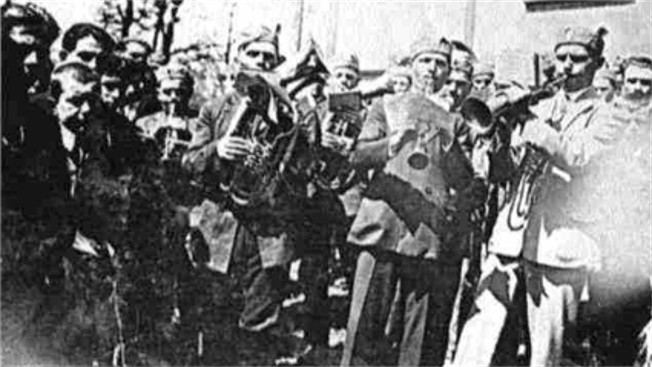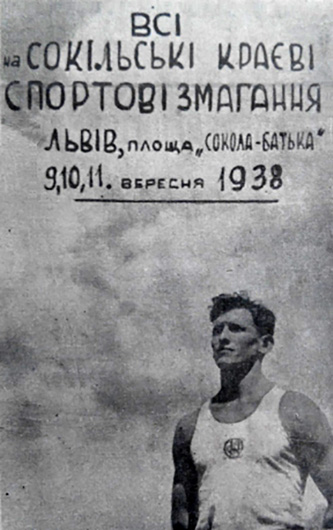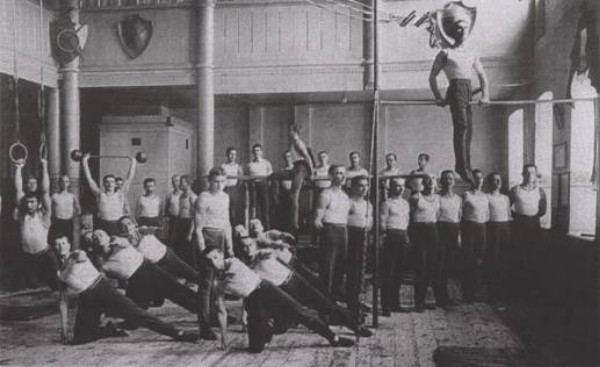Sokil
Sokil («Сокіл»; Falcon; Czech: Sokol). A mass physical-education movement that played an important role in the national rebirth of several Slavic peoples, particularly the Czechs. The first Sokol society was founded in Prague in 1862. Other Slavic peoples followed the Czechs' example and established their own counterparts. In 1907 the national societies came together to form the Sokol Union, which organized international meets and congresses. After the Soviet occupation of Eastern Europe, the Sokol movement was suppressed. Some societies are still active in the various Slavic émigré communities.
The Polish Sokół society was founded in Lviv in 1867, and the Ukrainian Sokil society was founded there in February 1894. The latter's statute was based on that of the Czech Sokol society, and its activity extended to all of Galicia and Bukovyna. There it propagated national unity, self-confidence, and dignity through physical education. The first president was Vasyl Nahirny (1894–1900), and the first director was V. Lavrivsky. A. Budzynovsky initiated the expansion of the society's program to encompass fire fighting (practiced until 1932), hiking, fencing, cycling, and shooting (from 1912). Besides physical activities and sports, the society also encouraged amateur choral, orchestral, and theatrical activities. In 1912 rifle units were organized by Semen Goruk; thenceforth the society was often known as the Sokil Physical Activity and Riflemen's Society. Ivan Bobersky, who headed the Sokil teachers' circle from 1901 and presided over Sokil in 1908–12, contributed greatly to Sokil's growth in the decade before the First World War. In Galicia's towns, beginning with Stanyslaviv (1902), branches concentrating primarily on physical education were set up, while those founded in rural areas usually combined physical education and fire fighting. The local branches, which were free to call themselves Sich or Sokil, grew in number from 6 in 1902 to 70 in 1903, 243 in 1905, 373 in 1907, 601 in 1910, and 974 in 1914. They were concentrated mostly in Lviv county and Galician Podilia. In Pokutia and Bukovyna, where the Sich societies attracted most of their followers, only a few Sokil branches existed. The combined Sokil membership grew to approximately 33,000. The parent organization in Lviv served as the central office of the movement; from 1909 it was called Sokil-Batko (‘Sokil-Father’).
Like the rival Sich societies movement, Sokil organized regional (in 1906 in Stryi and in 1910 in Ternopil) and then provincial assemblies (in 1911 in Lviv) of its constituent organizations. In June 1914 the so-called Shevchenko assembly was attended by 12,000 members of Sich, Sokil, and the Plast Ukrainian Youth Association. It was held at the Ukrainskyi Horod, the sports field owned by Sokil-Batko in Lviv. In 1912 Sokil representatives took part in the All-Slavic Sokol congress and games in Prague celebrating the 50th anniversary of the Czech society.
Before the First World War the more important figures in the Sokil movement were Klym Gutkovsky, Volodymyr Shukhevych, Yu. Vintskovsky (head of the photography and cycling sections), Yaroslav Yaroslavenko (composer of the Sokil anthem and other Sokil songs), Mykhailo Voloshyn, Y. Domanyk, Lev Lepky, and R. Dyhdalevych.
In Russian-ruled Ukraine several dozen Russian Sokol gymnastics societies were founded in the early 20th century. The largest society was in Kyiv. It hosted the 1913 Russian Sokol congress attended by 250 members from Katerynoslav, Odesa, Kharkiv, Chernihiv, Tahanrih, and Kursk.
The First World War interrupted the activities of the Sokil society in Galicia. After the war the Polish authorities obstructed the revival of the movement and prohibited its expansion into Volhynia, Podlachia, the Kholm region and the Lemko region. In 1918–20 only Sokil-Batko was able to function, and the 1933 law on associations precipitated the further decline of Sokil. In 1938 the Polish government seized, under the pretext of military need, Sokil-Batko's sports field in Lviv. The number of Sokil branches varied from 6 in 1921 to 37 in 1923, 586 in 1928, 493 in 1930, 370 in 1934, 233 in 1936 (23,000 members), and 300 in 1939 (approximately 35,000 members). From 1933 Sokil devoted more attention to athletics and sports (volleyball, basketball, track-and-field sports, and boxing); its sports section was headed by Osyp Navrotsky. Before the Ukrainian Sports Union was founded in 1925, and after it was abolished by the Polish authorities in 1937, Sokil-Batko functioned as the central office for the many sports clubs in Galicia. It organized the so-called Zaporozhian Games in 1923 and the third provincial Sokil assembly in 1934. It continued holding various regional Sokil public gatherings and events and conducting courses for physical education instructors.
Prominent figures in Sokil in the 1920s and 1930s, in addition to those who had already been important before the war, were Mykola Zaiachkivsky (president, 1922–33), Mykhailo Khronoviat (president, 1934–9), Stepan Haiduchok, M. Tril, I. Mryts (head of the skiing section), Mykhailo Halibei, Ya. and E. Blahitka, T. Bilostotsky, Edvard Zharsky, and Andrii Palii.
Sokil published the monthly magazines Visty z Zaporozha (1910–14) and Sokil’s’ki visty (1928–39); annual almanacs from 1894; and many sports, education, and organizational booklets by authors such as V. Lavrivsky, A. Budzynovsky, Ivan Bobersky, Stepan Haiduchok, M. Tril, O. Verkhola, Edvard Zharsky, Ya. Blahitka, Petro Franko, D. Navrotska, Taras Franko, D. Siiak, K. Sukhoverska, and I. Mryts.
Outside Ukraine the most active Ukrainian Sokil societies were founded by émigrés in interwar Czechoslovakia. There, beginning in 1922, Sokil branches sprang up in Poděbrady, Prague, Příbram, Liberec, Brno, and other towns. Together they formed the Union of the Ukrainian Sokil Movement Abroad in 1932; in 1934 it had 460 members. The societies took part in Czech Sokol events, sometimes as representatives of the Galician Sokil movement, and maintained contacts with Sokil-Batko and Ivan Bobersky in Canada and then Yugoslavia. The German occupation of Czechoslovakia brought an end to the Sokil movement in Czechoslovakia. Elsewhere, small Sokil groups existed in Zagreb, Riga, Harbin, Bucharest, Brazil, Paris, and Shanghai. A Sokil society was set up in Buenos Aires in 1931, and several smaller branches were organized in Argentina. In the United States, a small Sokil society was founded in New York in 1913. Unlike the Sich societies, however, the Sokil movement did not take root in North America.
Edvard Zharsky
[This article originally appeared in the Encyclopedia of Ukraine, vol. 4 (1993).]



